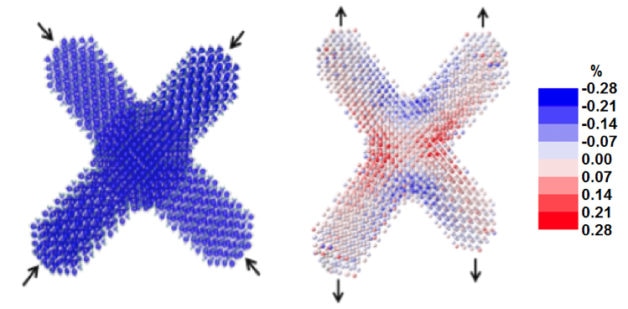Sep 20 2016
 These atom-scale computer simulations of tetrapods show how they sense compression (left) and tension along one axis (right), both of which are crucial to detecting nanoscale crack formation. The color bar indicates the percent change of the tetrapods’ volume. (Credit: Berkeley Lab)
These atom-scale computer simulations of tetrapods show how they sense compression (left) and tension along one axis (right), both of which are crucial to detecting nanoscale crack formation. The color bar indicates the percent change of the tetrapods’ volume. (Credit: Berkeley Lab)
Researchers at the U.S. Department of Energy’s Lawrence Berkeley National Laboratory (Berkeley Lab) and UC Berkeley have proposed that four-armed, light-emitting nanocrystals could soon serve as the foundation of an early warning system in structural materials by revealing microscopic cracks that indicate failure.
The research team embedded tetrapod-shaped quantum dots - nanosized semiconducting particles - into a polymer film. The cores of the tetrapods discharge fluorescent light when their arms are bent or twisted out of shape.
This indicates that the polymer is enduring a degree of tensile or compressive strain, where stress across sub-micron-scale regions of the material can be noticed. This sort of stress can make nanoscale cracks develop into macroscopic failure.
Preliminary tests reveal the tetrapods can cycle over 20 times and still maintain their ability to sense stress. They also do not lower the strength of the polymer where they are matrixed.
Until now the approach was only tested in the lab by the researchers, however in practice an off-the-shelf, portable spectrometer is all that is required to detect the fluorescent warning of the tetrapods.
A spectrometer can be pointed at an airplane wing, a steel beam or any material that has the tetrapods embedded inside. The instrument could potentially detect developing cracks that are just 100 nm in length.
“This is the length scale at which cracks develop, which is when you want to catch them, well before the material fails,” says Shilpa Raja, who conducted the research while she was an affiliate in Berkeley Lab’s Materials Sciences Division and a PhD student at UC Berkeley.
Raja is now a postdoctoral scholar at Stanford University. Robert Ritchie and Paul Alivisatos, also of the Materials Sciences Division and UC Berkeley, are the co-corresponding authors of a paper on this research published online in the journal Nano Letters.
Our approach could also be a big step toward self-healing smart materials. The tetrapods could be coupled with nanosized repair particles to form a material that senses local stress and then repairs itself.
Shilpa Raja, Stanford University
In addition to materials applications, the tetrapods can potentially be used to detect the presence of cancerous cells in tissue samples. This would be possible as cancerous cells have different mechanical characteristics than healthy cells, such as increased stiffness.
To develop the method, the team started with a polymer extensively used in airframes and other structures. They blended tetrapod nanocrystals into the polymer and cast slabs of the mixture in petri dishes. The slabs were then mounted on a tensile tester and a laser was directed on it. This allowed the team to concurrently measure the fluorescence and mechanical stress of the slab.
This is a low-cost fabrication technique, and it resulted in the best optomechanical agreement between fluorescence and mechanical tests sensed by a nanocrystal in a film.
Shilpa Raja, Stanford University
Raja says the shape of the tetrapods make them highly sensitive to stress. Their four arms serve as antennae that absorb stress from their surrounding environment, amplify the stress, and shift it to the core. The color of light discharged by the core points to the degree of stress felt by the arms.
Their method promises to be a huge enhancement over existing methods to detect nanoscale stress in materials, especially in the field. This can be performed in the lab with methods such as atomic force microscopy and nano-indentation methods, but this has to be a highly controlled environment.
In the last five years, researchers have developed methods to matrix other stress-sensing nanoparticles into materials, but these techniques do not use visible light detection and have minimal signal-to-noise ratio. Additionally, some of these methods degrade the material’s mechanical properties they are embedded in, or they cannot cycle to and fro, meaning they can only emit a warning signal just once.
Electron tomography of the tetrapods under stress was conducted at the Molecular Foundry. Atom-scale computer simulations of the tetrapod were conducted at the National Energy Research Scientific Computing Center (NERSC). Both facilities are DOE Office of Science User Facilities located at Berkeley Lab.
The research was funded partially by the Department of Energy’s Office of Science.